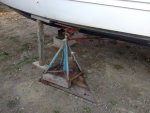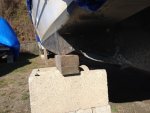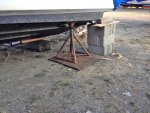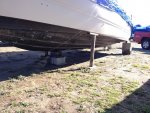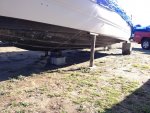Ryland3210
Seaman
- Joined
- Jul 21, 2015
- Messages
- 60
A winterizing publication recommends three jackstands on each side boats exceeding 26 feet. Mine is 28.5 and weighs 7300 pounds. The marina place two wooden blocks under each side of the boat. They are right at the aft end of the hull and at the out edge of the transom.
The two jackstands are at the locations where the lifting is indicated, also at the outer edge of the hull.
This seems like enormous pressure points are being created, especially at the transom. The marina also leaves outdrives in the full up trailer position, which I have been told can lead to premature failure of the bellows. The publication recommends lowering the out drive onto a block to help support the weight.
Should I worry?
The two jackstands are at the locations where the lifting is indicated, also at the outer edge of the hull.
This seems like enormous pressure points are being created, especially at the transom. The marina also leaves outdrives in the full up trailer position, which I have been told can lead to premature failure of the bellows. The publication recommends lowering the out drive onto a block to help support the weight.
Should I worry?





















